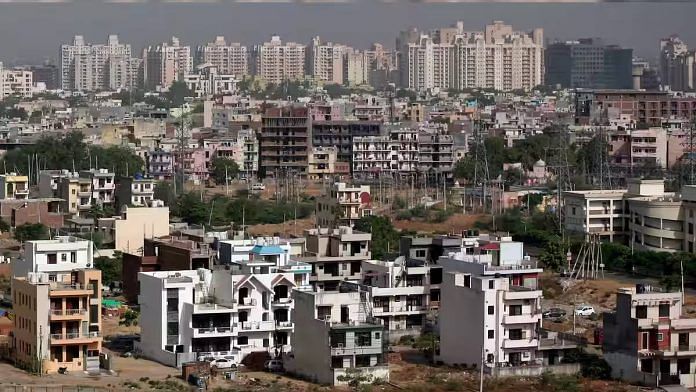New Delhi: The central government is planning to redevelop five more government residential colonies in Delhi to meet the housing requirements of officials in the national capital, ThePrint has learnt.
The five colonies, part of the Centre’s General Pool Residential Accommodation (GPRA) for allotment of flats to government officials, are located in Andrews Ganj, DIZ Area (Mandir Marg), Pushp Vihar (south Delhi), Timarpur (north Delhi) and Lodhi Road (Lodhi Colony).
A meeting to discuss the redevelopment of these colonies was held in the ministry of housing and urban affairs Tuesday and was attended by officials from the National Buildings Construction Corporation (NBCC India, a central PSU), officials said.
In 2016, the Centre had approved the redevelopment of seven GPRA colonies located in south Delhi — Sarojini Nagar, Nauroji Nagar, Kasturba Nagar, Netaji Nagar, Srinivaspuri, Mohammadpur and Thyagraj Nagar.
Speaking about the latest redevelopment plan, a senior ministry official said: “Earlier this year, the ministry tasked the National Buildings Construction Corporation to carry out a survey of flats which were in bad condition in the five GPRA colonies and prepare a redevelopment plan.”
“These colonies were developed more than four decades ago and have a large number of housing units, mostly Type I, lying in a deteriorated condition. We plan to raze these flats, which are mostly vacant, and redevelop the area to meet the housing requirements. NBCC has identified close to 12,000 such flats in these five colonies. So far, no final decision has been taken on these plans,” the official added.
Eight types of flats are constructed under the GPRA, which vary in size — from 34 square metre (Type I) to around 403 square metre (Type VIII) for government officials and Members of Parliament. Type VII and VIII are for MPs and ministers.
A second ministry official told ThePrint that the central government’s plan is to construct over 6,000 Type III and above flats by demolishing 12,000 flats, mostly Type I, in five GPRA colonies.
“The government no longer constructs Type I flats and the majority of flats in these five colonies are of Type I category. The NBCC has been asked to accordingly work on a redevelopment plan,” said the second official.
The redevelopment of the five GPRA colonies is likely to cost around Rs 8,000 crore to Rs 10,000 crore and, once final, the proposal will be sent to the Public Investment Board and then to the Union Cabinet for approval, the officials explained.
“The plan is in the initial stages and details are being worked out. We are also assessing if more government colonies can be added to the list if there is a housing inventory of existing stock that’s lying in bad condition. The NBCC has been asked to explore all possibilities,” said the first official.
ThePrint reached a spokesperson in the housing ministry with queries on the subject. This report will be updated if and when a response is received.
Also Read: Govt plans to use 3D land mapping of MGNREGS work sites to monitor progress, prevent fund misuse
Options being explored
The total area available for redevelopment in these five GPRA colonies is around 130-140 acres. The Type I flats are constructed in one portion of these colonies.
“Only the flats which are in bad condition will be redeveloped. Therefore, just a portion of the colonies will be taken up for redevelopment, unlike the other seven GPRA colonies where the entire area is being redeveloped,” said the second ministry official.
The ministry is also exploring various options to ensure that the cost of redevelopment is recovered from a commercial component, such as office or retail space, or through land monetisation, such as selling land parcels to private developers or constructing residential units and selling them off.
“Various options are on the table. Timarpur and Pusph Vihar are located far from central government offices. The possibility of either constructing residential flats in these areas or monetising land in these colonies is being considered to recover the cost of the project,” said the first official, adding that “in the other three colonies, more than 6,000 flats for government employees will be constructed”.
“There is another possibility of developing a commercial component just like we did in the East Kidwai Nagar redevelopment project,” the first official added.
Status of older project
In 2016, the Centre had approved the redevelopment of seven GPRA colonies to construct close to 25,667 dwelling units at an estimated cost of Rs 32,835 crore. There were 12,970 dwelling units in these seven colonies earlier which were razed to pave the way for redevelopment.
The number of dwelling units to be constructed was later revised to around 19,000, said the first official.
Construction work at the seven GPRA colonies is proceeding at a fast pace, according to officials, and close to 900 flats in Sarojini Nagar are likely to be completed by the end of this year, as is a commercial complex in Nauroji Nagar.
The redevelopment work is being carried out by NBCC India along with the Central Public Works Department (CPWD), the Centre’s construction arm.
While the entire redevelopment project is slated to be completed by 2025, housing minister Hardeep Singh Puri inaugurated two redeveloped colonies (Thyagraj Nagar and Mohammadpur) in April this year, where 1,400 government employees have been allotted flats.
In March this year, the ministry sent the seven colonies’ redevelopment project to the Public Investment Board, under the Union finance ministry, for review due to cost overrun as the original plan has undergone several changes, said ministry officials.
The second senior ministry official quoted above told ThePrint: “A 14-km elevated corridor was added to the project later, which will cost around Rs 5,000 crore. Other changes have also been made to the plan. We had recommended monetising land in these colonies. The proposal will be sent to the Union Cabinet for approval next.”
(Edited by Nida Fatima Siddiqui)
Also Read: 30 years of law to empower municipalities: Why agencies remain ‘toothless’ & mayors ‘weak’



